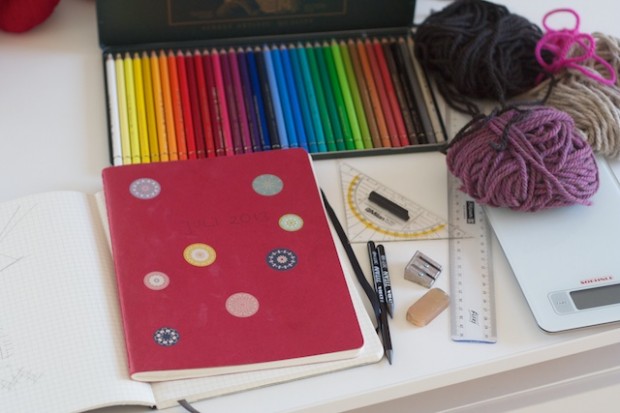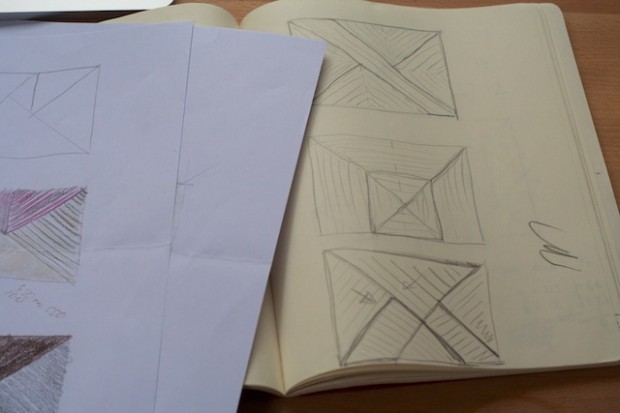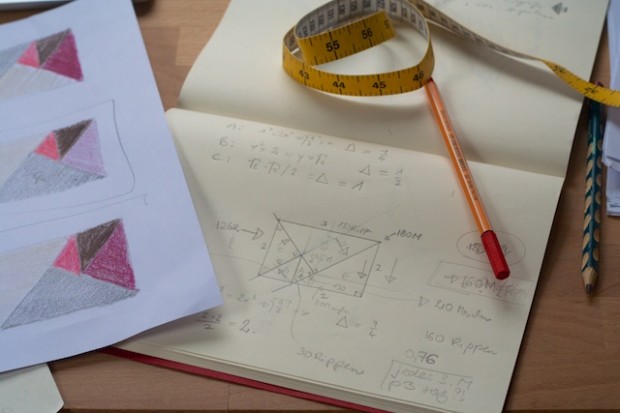Designing – I
So what does the design process look like? I am sure that every knitwear designer has a different answer to this one. So here is what works for me:
The Idea.
There are different sources of inspiration. Sometimes I find some yarn that just begs to be something really special. Like this beautiful Wollmeise Molly (discontinued, unfortunately) in “Dunkle Kirsche”. I knew I wanted to make a cabled sweater with it, but could not find any pattern I liked. So I made “Joanie”, a pattern that was later published in Knitty.com.
I might also think about a special shape or a concept that I want to use for a particular finished item. It might be a geometric form I have seen in nature, on a building or in a picture: A long, narrow triangle, a long hexagon that could be knit without any purl stitches, a bias-knit hat. For my new pattern “Angles“, I wanted a rectangular shape that was composed of various triangles.
The Sketches.
Now I start sketching, using pencil and paper, sometimes compasses, a ruler, and always my eraser. I lack the routine of doing sketches on the computer – and I just love using old-fashioned drawing tools, pretty pencils and crayons. I feel like I am working on the intersection of art and geometry, which – in my view – is a place very close to paradise.
My favorite drawing tool is my thick “6B” graphite pencil in the front of the picture (I have used it so much that it is very short now and sadly will need a replacement). It makes soft, wide lines and is a joy to work with. For rough sketches, I use unruled Moleskine notebooks (a small luxury – and I think their size is just perfect) or I steal a couple of A-4-sized sheets from our printer. And for those cases where colored sketches are called for, I gifted myself that big beautiful case of colored crayons that can be seen in the back of the picture.

Now I start to scribble and draw and collect ideas: With pencil in hand, sometimes something very different emerges from what I first had in mind. With “Angles”, the challenge was to construct a rectangle using only triangular shapes that would grow modularly onto one another without any seams. It was an interesting puzzle that I enjoyed working on quite a bit.
By the way: There are a lot of ideas in my sketchbooks that did not make it to the next step: Shawlettes, sweaters, vests, jackets that did not spark my enthusiasm enough to take them to the next level.

Coming up in Part II: Numbers before needles – Start Small


hallo martina,
wir alle profitieten davon, daß du dein talent mit freude zum ziel bringst!
mittlerweile sind deine strickideen, welche ich am häufigsten stricke! dadurch fühle ich ein wenig von deiner freude beim kreiren nach, denn ich verstehe deinen leitgedanken. sicher geht das nicht nur mir so.
ich bin schon wieder auf das nächste anleitungsbüchlein gespannt – mit spiralbindung so genial!
mit deinem talent bereitest du nicht nur freude, sondern du trägst zum lebensunterhalt deiner familie bei und das ist der absolut richtige weg!
ganz liebe grüße aus koblenz am rhein,
jutta